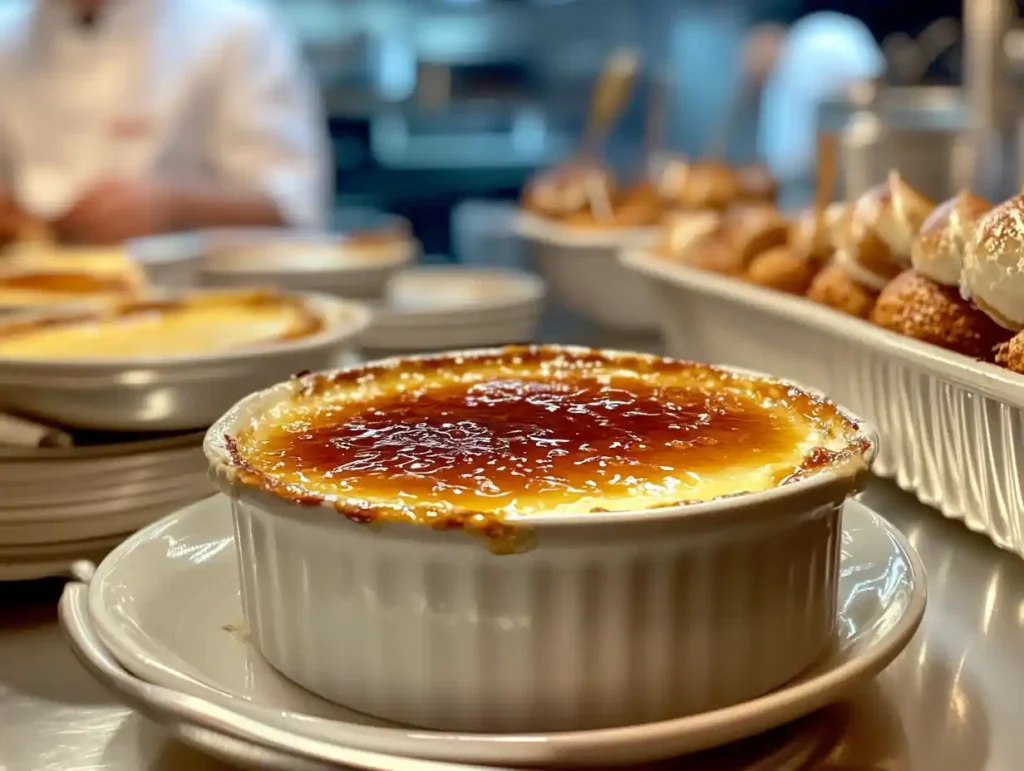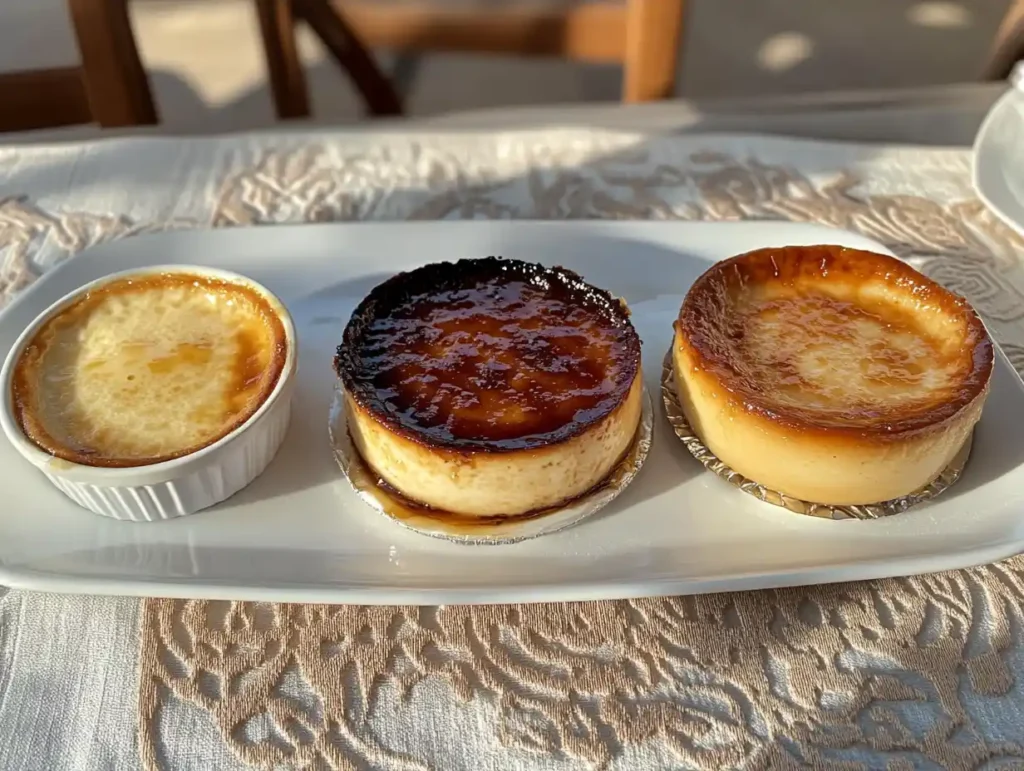Introduction
Crème brûlée is a dessert that exudes elegance and sophistication. Its creamy, luscious base paired with a crackling caramelized sugar topping has made it a staple in fine dining menus across the globe. But have you ever wondered what this French term actually means? Exploring the origins and meaning of “crème brûlée” gives us a glimpse into its cultural and culinary significance. In this article, we’ll dive into the literal translation, historical background, preparation techniques, and why this dessert holds such an esteemed place in gastronomy.
Origins and Meaning
What Does “Crème Brûlée” Mean?
“Crème brûlée” is a French phrase that translates to “burnt cream” in English. This name perfectly describes the dessert’s defining feature: a smooth custard base topped with a layer of caramelized sugar that is torched or broiled until it forms a brittle crust. While the term may sound simple, its elegance and complexity in taste and texture have made it an icon of French cuisine.
The Literal Translation of Crème Brûlée
Breaking down the term:
- Crème: This word directly translates to “cream,” signifying the dessert’s rich, creamy foundation, which is made from ingredients like heavy cream, egg yolks, and vanilla.
- Brûlée: The word means “burnt” or “scorched,” referring to the caramelized sugar topping that’s created using an open flame or a broiler. The term reflects both the dessert’s preparation method and its unique texture.
Cultural Context of Crème Brûlée
In French culture, crème brûlée represents a perfect balance between artistry and simplicity. The dessert is not just a treat but also a symbol of refinement and indulgence, often served at celebratory dinners or in upscale restaurants. It showcases the French dedication to culinary precision, with its silky custard and delicate caramelized crust exemplifying the art of mastering textures and flavors.
Historical Background
Origins of Crème Brûlée in French Cuisine
The exact origin of crème brûlée is a subject of debate among culinary historians, with claims of its invention in France, England, and Spain. However, the French have undeniably played a key role in popularizing this dessert, and the name itself is unmistakably French. Its roots in French cuisine trace back to the 17th century, where it was a favorite among the aristocracy.
Early Mentions of Crème Brûlée in History
The earliest recorded mention of crème brûlée appears in François Massialot’s 1691 cookbook Le Cuisinier Royal et Bourgeois. Massialot, a chef who served the French court, detailed a recipe that closely resembles the modern version of crème brûlée. Interestingly, in his recipe, the sugar topping was caramelized using a hot fire shovel instead of the kitchen torches we use today.
Evolution of the Recipe Through Time
Over the centuries, crème brûlée has evolved, with chefs experimenting with different flavors like citrus, lavender, and even coffee. In the 20th century, the dessert saw a resurgence in popularity, thanks to its inclusion on the menus of high-end French restaurants and its adaptability to contemporary culinary trends. Today, it remains a timeless classic with a global appeal.
Key Ingredients and Preparation
Traditional Ingredients of Crème Brûlée
Crème brûlée is celebrated for its simplicity, relying on just a handful of high-quality ingredients to create its luxurious flavor and texture. The core components include:
- Heavy Cream: The base ingredient, providing richness and creaminess.
- Egg Yolks: Essential for achieving the custard’s velvety texture.
- Granulated Sugar: Used in both the custard mixture and for the caramelized topping.
- Vanilla Bean or Extract: Adds a warm, aromatic flavor to the custard.
The minimalism of these ingredients underscores the importance of using the best possible quality to achieve a perfect dessert.
How Crème Brûlée Is Made: A Step-by-Step Guide
Making crème brûlée involves precision and care. Here’s a step-by-step overview of the process:
- Prepare the Custard Base: Combine heavy cream and vanilla, then heat gently to infuse the cream with flavor.
- Mix the Egg Yolks and Sugar: Whisk egg yolks with sugar until pale and smooth.
- Combine and Temper: Gradually pour the warm cream into the yolk mixture, whisking continuously to prevent curdling.
- Bake in a Water Bath: Pour the custard mixture into ramekins and bake in a water bath to ensure even cooking and prevent cracking.
- Cool and Chill: Allow the custards to cool to room temperature before refrigerating for several hours to set.
- Caramelize the Sugar: Sprinkle sugar evenly over the custard and caramelize with a kitchen torch or under a broiler until golden and crisp.
Variations in Ingredients Across Regions
While the classic vanilla flavor remains the most popular, variations in crème brûlée recipes can be found worldwide:
- France: Often retains the traditional vanilla recipe but may include liqueurs like Grand Marnier.
- Spain: Similar to Catalan cream, with a hint of citrus or cinnamon.
- Modern Takes: Flavors like matcha, chocolate, or lavender cater to contemporary tastes.
These variations showcase the versatility of crème brûlée and its ability to adapt to different culinary traditions.
Crème Brûlée in Modern Culture

The Popularity of Crème Brûlée Around the World
Crème brûlée has transcended its French origins to become a beloved dessert globally. Its inclusion on menus in countries like the United States, Japan, and Australia highlights its universal appeal. It has also become a frequent feature in cooking competitions and culinary shows, cementing its status as a gourmet delicacy.
Signature Features That Make Crème Brûlée Unique
What sets crème brûlée apart is its dual texture: the contrast between the creamy custard base and the brittle caramelized topping. The experience of cracking through the sugar crust with a spoon, followed by the indulgent custard beneath, is part of its charm.
Crème Brûlée in French Restaurants
In France, crème brûlée is a staple of fine dining. It is often served with artistic flair, emphasizing the French ethos of combining flavor with presentation. Many chefs view it as a testament to their culinary skill, given the precision required to perfect the sugar crust and custard consistency.
Comparisons to Similar Desserts

Crème Brûlée vs. Custard: Key Differences
Although crème brûlée is technically a type of custard, it stands apart due to its caramelized sugar topping. Custards, such as those used in pies or trifles, are typically softer and lack the signature crunchy crust that defines crème brûlée. The latter is also served individually in ramekins, highlighting its gourmet presentation.
How Crème Brûlée Differs from Flan and Pudding
- Flan: Flan is a Spanish dessert with a similar custard base, but its caramel is liquid rather than hardened. Unlike crème brûlée, the caramel in flan is poured on top before serving, creating a softer texture.
- Pudding: Pudding, especially in English-speaking countries, is often thicker and uses starch as a thickening agent. Crème brûlée, in contrast, achieves its texture solely from eggs and cream, giving it a silkier consistency.
Unique Appeal of Crème Brûlée in Global Desserts
Crème brûlée’s allure lies in its theatrical presentation and the interplay of textures. The act of caramelizing sugar at the table or allowing diners to crack the crust adds a sensory experience that other desserts lack. This has helped it maintain a prestigious reputation in both traditional and modern culinary settings.
FAQs
What Is the Origin of the Term “Crème Brûlée”?
The term “crème brûlée” comes from the French language, translating directly to “burnt cream.” It references the dessert’s caramelized sugar topping, created by burning sugar with a torch or under a broiler. The phrase not only describes the dessert’s signature feature but also conveys the simplicity and elegance characteristic of French culinary terminology. The first recorded use of the term dates back to the 17th century, emphasizing its longstanding presence in French gastronomy.
How Do You Pronounce “Crème Brûlée” Correctly?
Pronunciation plays an important role in appreciating French culinary terms. “Crème brûlée” is pronounced as krem broo-LAY:
- “Crème” rhymes with “gem,” with a soft “k” sound at the start.
- “Brûlée” uses a French “u,” sounding similar to “oo” in “blue,” and the ending “lée” is pronounced as “lay.”
Learning the correct pronunciation not only adds to your culinary knowledge but also helps in confidently ordering this dessert in authentic French settings.
What Are the Key Characteristics of Crème Brûlée?
The hallmark of crème brûlée is its dual-texture contrast:
- Creamy Custard Base: Made from heavy cream, egg yolks, sugar, and vanilla, the custard is smooth, rich, and infused with subtle flavors.
- Caramelized Sugar Topping: A thin layer of granulated sugar is caramelized to form a crackly crust, which diners break through with a spoon.
The visual appeal, indulgent texture, and harmonious balance of sweetness and creaminess make it a standout dessert.
Is Crème Brûlée Only a French Dessert?
While crème brûlée is famously French, similar desserts exist in other cultures:
- Spain: Crema catalana is considered a precursor to crème brûlée, flavored with citrus and cinnamon.
- England: A dessert called “burnt cream” has similarities, though it lacks the finesse of its French counterpart.
Despite these overlaps, the French version is unique in its name, preparation, and presentation, solidifying its identity as a quintessentially French dessert.
What Makes Crème Brûlée Stand Out Among Desserts?
Crème brûlée’s appeal lies in its luxurious simplicity. Unlike many desserts that rely on elaborate decorations or multiple layers, crème brûlée captivates with its:
- Interactive Experience: The act of cracking the caramelized crust adds an element of excitement.
- Elegant Presentation: Served in individual ramekins, crème brûlée looks refined and inviting.
- Harmonious Flavors: The warm, caramelized top complements the cool, creamy custard beneath.
This combination of sensory delights makes crème brûlée a favorite in fine dining and home kitchens alike.
Can Crème Brûlée Be Made at Home Easily?
Yes, crème brûlée can be made at home with a little preparation and the right tools. Key steps for success include:
- Equipment: A kitchen torch is essential for achieving the signature caramelized crust.
- Technique: Use a water bath when baking the custard to prevent cracking or overcooking.
- Quality Ingredients: Opt for high-quality cream, fresh eggs, and authentic vanilla to capture the dessert’s rich flavor.
Although it requires attention to detail, many home cooks find the process enjoyable and rewarding. Plus, making crème brûlée at home allows for creative twists, such as adding unique flavors like coffee, lavender, or matcha.
Related Recipes and Culinary Insights
If you’re exploring What Does Crème Brûlée Mean in French?, here are some related guides and recipes to enhance your knowledge of this classic dessert:
- What Is the Secret to Crème Brûlée? Expert Tips Revealed – Learn the techniques behind this iconic French dessert.
- What Is Crème Brûlée Mostly Made Of? – A breakdown of the key ingredients in this dish.
- Vanilla Bean Paste: Everything You Need to Know – Dive deeper into the importance of vanilla in French desserts.
These resources will give you a comprehensive understanding of Crème Brûlée and its rich culinary heritage!
Conclusion
Crème brûlée, or “burnt cream,” is much more than its name suggests. This iconic French dessert represents a perfect blend of culinary simplicity and sophistication. Its rich history, unparalleled texture, and universal appeal make it a true masterpiece of the dessert world. Whether enjoyed at a fine dining restaurant or prepared in a home kitchen, crème brûlée continues to captivate dessert enthusiasts worldwide.
